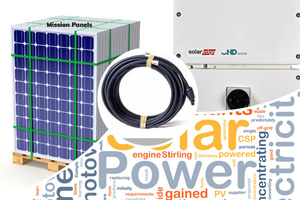Oklahoma's sunny skies are a golden opportunity to power your home with clean, renewable energy. Installing a DIY residential solar kit can be a rewarding experience, saving you money on your electricity bills and reducing your carbon footprint. But with the vast array of kits and information available, it's crucial to navigate the process with knowledge and confidence.
This comprehensive guide will equip you with everything you need to know about DIY solar kits in Oklahoma, from choosing the right system to installation and beyond.
The financial benefits of solar power are undeniable. Oklahoma offers generous net metering policies, allowing you to sell excess solar energy back to the grid, essentially crediting your electric bill. Studies show that Oklahoma homeowners can save an average of $1,000-$2,000 annually on their electricity bills with a well-designed solar system.
Before diving into specific kits, it's important to assess your home's energy needs. Consider your average monthly electricity usage, available roof space, and budget. Online tools like the National Renewable Energy Laboratory's PVwatts can help estimate your solar energy potential.
Grid-tied kits: These connect to your existing electrical grid, allowing you to use solar power and supplement it with grid electricity when needed.
Off-grid kits: Ideal for remote locations, these kits store solar energy in batteries for independent power.
Hybrid Kits: Great for a combinatiodn of on-grid, off-grid, hooking up to generators or wind turbines Perfect for homes or small cabins.
Panel wattage and efficiency: Higher wattage panels generate more power, but may require more roof space. Efficiency measures how much sunlight is converted to electricity.
Inverter type: String inverters are cost-effective for smaller systems, while microinverters provide better performance for shaded roofs or systems with different panel orientations.
Mounting hardware: Ensure the kit includes compatible mounting hardware for your roof type and local wind and snow loads.
Warranties: Look for long-term warranties on panels, inverters, and other components.
Installing a DIY solar kit requires careful planning, technical knowledge, and safety precautions. If you're a confident DIYer, online resources, manufacturer manuals, and video tutorials can guide you through the process. However, consider your skillset and comfort level. Hiring a professional installer for critical steps like electrical connections ensures safety and system optimization.
Permits and Inspections: Permits and inspections are typically required for solar installations. Contact your local building department and utility company to understand the specific regulations in your area.
Oklahoma Solar Incentives: Oklahoma offers various incentives to encourage solar adoption, including:
Federal tax credit: Enjoy a 30% tax credit on the cost of your solar system.
Net metering: Sell excess solar energy back to the grid and receive credits on your electricity bill.
Property tax exemption: Some Oklahoma counties offer property tax exemptions for solar systems.
Beyond the Kit: Owning a solar system requires ongoing maintenance. Regularly clean your panels, monitor performance, and address any potential issues promptly. Remember, your investment in solar power is a long-term commitment to clean energy and financial savings.
Owning a solar system requires ongoing maintenance. Regularly clean your panels, monitor performance, and address any potential issues promptly. Remember, your investment in solar power is a long-term commitment to clean energy and financial savings.
By following these steps and conducting thorough research, you can confidently embark on your DIY solar journey. Remember, knowledge is power, and with the right preparation, you can enjoy the sun-powered benefits of a DIY residential solar kit for years to come
.Solar panels: The powerhouses that convert sunlight into electricity. Choose high-quality panels with efficient ratings.
Mounting system: Structures that securely attach the panels to your roof.
Inverter: Converts the panel's DC output to usable AC electricity for your home.
Charge controller (for off-grid systems): Regulates battery charging to prevent overcharging or damage.
Batteries (for off-grid systems): Store excess solar energy for use when the sun isn't shining.
Wiring and connectors: The safe and efficient pathways for electricity to flow.